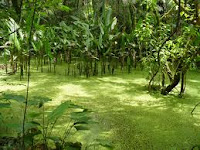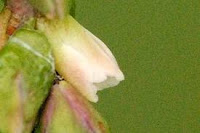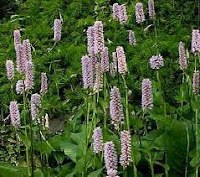The common bulrush grows in shallow water in all temperate, tropical and sub-tropical regions in the Northern hemisphere and is a native rush in Britain
The roots of the bulrush may be boiled and eaten as you would a potato; and if they are macerated and then boiled they will produce and edible sweet syrup. You can dry the roots and grind them to a powder which, if added to wheat flour enriches it, as the root is not only starchy but contains protein. This mixture can be used to make bread etc.
 The young shoots can be eaten raw or cooked in spring, and can be cooked and used as a substitute for asparagus; in fact they are sometimes called “Cossack’s asparagus.” They are said to taste like cucumbers. You can actually eat the shoots when they are up to 50 centimetres in length, and the base of the stem when it is mature, can be eaten too, either raw or cooked, although it is best to remove the outer layer of the stem.
The young shoots can be eaten raw or cooked in spring, and can be cooked and used as a substitute for asparagus; in fact they are sometimes called “Cossack’s asparagus.” They are said to taste like cucumbers. You can actually eat the shoots when they are up to 50 centimetres in length, and the base of the stem when it is mature, can be eaten too, either raw or cooked, although it is best to remove the outer layer of the stem. The flower spike may also be eaten before it is ripe, either raw or in a soup, and this is said to taste like sweet corn. When ripe the seeds may be eaten either raw or roasted, although they are difficult to harvest. These have a nutty taste and may also be ground to be added to flour for baking purposes. They also produce an edible oil.
The pollen may also be eaten as it is protein-rich and can be added to flour. To gather the pollen you can shake the flower spike over a wide shallow container and then, with a fine brush, remove the remainder.
The whole plant has been used medicinally too, the dried pollen may be used on wounds as it will remove blood clots being an anticoagulant, although when it is roasted with charcoal it becomes haemostatic, and is used for haemorrhages, painful menstruation and kidney stones, as well as uterine bleeding, cancer of the lymphatic system, abscesses and post-partum pains.
However bulrushes should not be used during pregnancy.
A decoction of the stems has been used for whooping cough, and the roots have diuretic properties and promote the milk flow in breast-feeding mothers. They have been used in tonics and for their refrigerant properties. Pounded to a jelly they can be used as a poultice for wounds, cuts, burns and scalds.
The flowers have been used for stomach pains, lack of a woman’s periods, and irregular ones, as well as for cystitis. Eating the young flower heads is supposed to stop diarrhoea. The downy material from the seeds has been used to line a baby’s nappy and for wound dressings.
In autumn the leaves were gathered for thatching material, they can also be made into paper, and rayon has been made from their pulp. The stems were used for rush lighting, and the pollen, being highly inflammable has been used to make home-made fireworks. The stems can also be woven into mats, hats, and seats for chairs.
Despite these uses for bulrushes, Nicholas Culpeper, the 17th century English herbalist was very scathing about all rushes, including bulrushes, which he names particularly. He wrote this about rushes:-
 “The seed of the soft rushes, saith Dioscorides and Galen (toasted saith Pliny) drunk in wine and water, stayeth the lask and women’s courses, when too abundant; but it causeth head-ache; it provoketh sleep, but must be given with caution. The root boiled in water to one-third helpeth the cough.
“The seed of the soft rushes, saith Dioscorides and Galen (toasted saith Pliny) drunk in wine and water, stayeth the lask and women’s courses, when too abundant; but it causeth head-ache; it provoketh sleep, but must be given with caution. The root boiled in water to one-third helpeth the cough. What I have written here concerning rushes is to satisfy my countrymen’s question: Are our rushes good for nothing? Yes, and as good to let them alone as taken. There are remedies enough without them for disease, and therefore as the old proverb is, I care not a rush for them: or rather, they will do you as much good as if one had given you a rush.”
Clearly he didn’t like them much or think that they were efficacious in the treatment of any illnesses. Other plants were better.





















































